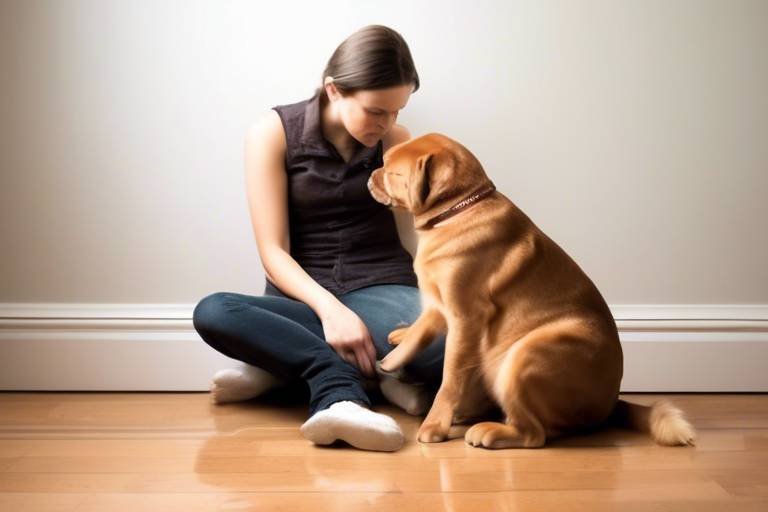The Benefits of Obedience Classes for Dogs
Have you ever wondered why some dogs seem to be better behaved than others? The answer often lies in the training they receive. Enrolling your furry friend in obedience classes can transform not only their behavior but also your relationship with them. Imagine a world where your dog listens to commands, interacts well with others, and feels confident in various environments. This article explores the numerous advantages of obedience classes, highlighting how they lead to improved behavior, enhanced bonding with owners, and increased socialization opportunities, ultimately resulting in a happier and healthier pet.
One of the most significant benefits of obedience classes is the improvement in your dog's behavior. These classes teach essential commands and manners, which can drastically reduce common behavioral issues like barking, jumping, and chewing. Think of it this way: just as children need guidance to learn proper behavior, dogs thrive on the structure and discipline provided in these classes. By establishing clear rules and expectations, you create a more harmonious living environment for both you and your pet.
Participating in obedience classes is not just about training; it's about building a stronger bond between you and your dog. The shared experience of learning and growing together fosters trust and understanding. Imagine your dog looking up at you, knowing that you are their reliable leader. This deep emotional connection enhances communication and creates a relationship built on mutual respect. When you attend classes together, you are not just teaching commands; you are creating memories and strengthening your partnership.
Through consistent training, dogs learn to trust their owners as reliable leaders. This trust is crucial for a well-behaved pet, as it encourages dogs to follow commands and feel secure in various situations. When a dog knows they can rely on you, they are more likely to listen and respond positively. It’s like having a safety net; they feel secure knowing you have their back.
Using positive reinforcement techniques during training helps dogs associate commands with rewards. This method not only improves learning but also strengthens the bond between owner and pet, making training a positive experience. Instead of punishment, think of rewards as little celebrations for good behavior. When your dog sits on command and receives a treat, they learn that good things happen when they listen to you.
Regular attendance at obedience classes reinforces the importance of consistency in training. This structure helps owners maintain their dog's progress and ensures that training remains a priority in their daily routine. Just like any skill, practice makes perfect. By committing to ongoing training, you are setting your dog up for success, and they will thrive under your guidance.
Obedience classes provide valuable socialization experiences for dogs, exposing them to other pets and people. This interaction is essential for developing a well-rounded dog that is comfortable in various environments. Imagine your dog confidently meeting new friends at the park instead of cowering in fear. Socialization not only helps in reducing anxiety but also enhances a dog's ability to interact positively with other animals and humans.
Training in obedience classes equips dogs with essential life skills, enabling them to navigate everyday situations more effectively. These skills contribute to a dog's overall confidence and adaptability in different settings. For instance, teaching your dog to stay calm during a thunderstorm or to walk politely on a leash can make everyday life much more enjoyable for both of you.
Teaching dogs to behave appropriately in public spaces is a key focus of obedience classes. This training helps reduce anxiety for both dogs and owners, allowing for enjoyable outings and interactions with others. Imagine being able to take your dog to a café without worrying about them jumping on strangers or barking at passing cars. It’s all about making your life easier while enhancing your dog's social skills.
Obedience training encourages dogs to think and respond to commands, enhancing their problem-solving abilities. This mental stimulation is crucial for a dog's overall well-being and can prevent behavioral issues from arising. Just like humans, dogs need challenges to keep their minds sharp. The more they learn, the more confident they become in navigating their world.
- How long do obedience classes typically last? Most classes last around 6 to 8 weeks, depending on the program.
- Can any dog benefit from obedience training? Absolutely! Dogs of all ages and breeds can benefit from obedience training.
- What should I bring to obedience classes? Bring your dog's favorite treats, a leash, and a positive attitude!

Improved Behavior
This article explores the numerous advantages of enrolling dogs in obedience classes, including improved behavior, enhanced bonding with owners, and increased socialization opportunities, ultimately leading to a happier and healthier pet.
Obedience classes are like a magic wand for dog owners, transforming unruly pets into well-behaved companions. When dogs learn essential commands and manners, it leads to better behavior not just at home, but also in public. Imagine a life where your dog doesn't bark incessantly at every passerby, jump on guests, or chew on your favorite shoes! Sounds dreamy, right? Well, that's exactly what obedience training can help achieve. By addressing common behavioral issues, these classes create a more harmonious living environment for both pets and their owners.
One of the key components of obedience training is the establishment of basic commands such as "sit," "stay," and "come." These commands serve as the foundation for good behavior. For instance, when a dog learns to sit on command, it not only makes it easier to manage them during walks but also reduces the likelihood of jumping on people. This is particularly important in social situations where a calm demeanor is essential. In fact, studies have shown that dogs trained in obedience classes exhibit significantly fewer behavioral problems compared to those who have not received any formal training.
Moreover, obedience classes often incorporate techniques that focus on curbing excessive barking, which can be a major nuisance. Trainers teach owners how to recognize the triggers for their dog's barking and provide strategies to redirect this behavior. For example, if a dog barks at strangers, the trainer might suggest a command that redirects the dog's attention. This not only reduces the barking but also strengthens the bond between the dog and its owner as they work together to solve the problem.
In addition to addressing barking and jumping, obedience classes also tackle issues like chewing. Dogs often chew on furniture or personal items out of boredom or anxiety. Through training, dogs learn what is acceptable to chew on and what isn't. This is where the concept of positive reinforcement comes into play. By rewarding dogs for using their chew toys instead of household items, owners can effectively curb destructive behaviors.
To give you a clearer picture, here’s a simple table summarizing some common behavioral issues and how obedience classes can help:
| Behavioral Issue | Obedience Class Solution |
|---|---|
| Excessive Barking | Teach commands to redirect attention |
| Jumping on Guests | Train to "sit" when greeting people |
| Destructive Chewing | Encourage use of chew toys through rewards |
Ultimately, the goal of obedience classes is to create a well-behaved dog that can be a joy to live with. The skills learned in these classes not only benefit the dog but also enhance the overall quality of life for the owner. Imagine taking your dog to a park without worrying about them running off or creating chaos. With improved behavior, outings become enjoyable experiences instead of stressful challenges.
Participating in obedience classes fosters a stronger bond between dogs and their owners. The shared experience of training builds trust and understanding, enhancing communication and creating a deeper emotional connection that benefits both parties.
Through consistent training, dogs learn to trust their owners as reliable leaders. This trust is crucial for a well-behaved pet, as it encourages dogs to follow commands and feel secure in various situations.
Using positive reinforcement techniques during training helps dogs associate commands with rewards. This method not only improves learning but also strengthens the bond between owner and pet, making training a positive experience.
Regular attendance at obedience classes reinforces the importance of consistency in training. This structure helps owners maintain their dog's progress and ensures that training remains a priority in their daily routine.
Obedience classes provide valuable socialization experiences for dogs, exposing them to other pets and people. This interaction is essential for developing a well-rounded dog that is comfortable in various environments.
Training in obedience classes equips dogs with essential life skills, enabling them to navigate everyday situations more effectively. These skills contribute to a dog's overall confidence and adaptability in different settings.
Teaching dogs to behave appropriately in public spaces is a key focus of obedience classes. This training helps reduce anxiety for both dogs and owners, allowing for enjoyable outings and interactions with others.
Obedience training encourages dogs to think and respond to commands, enhancing their problem-solving abilities. This mental stimulation is crucial for a dog's overall well-being and can prevent behavioral issues from arising.
- How long do obedience classes typically last? Most classes last between 6 to 8 weeks, with weekly sessions.
- Is my dog too old for obedience training? No, dogs of all ages can benefit from obedience training.
- What if my dog doesn't respond to commands? Patience and consistency are key; trainers can provide tailored strategies to help.

Enhanced Bonding
This article explores the numerous advantages of enrolling dogs in obedience classes, including improved behavior, enhanced bonding with owners, and increased socialization opportunities, ultimately leading to a happier and healthier pet.
Obedience classes instill essential commands and manners in dogs, leading to better behavior at home and in public. This training helps reduce common issues like barking, jumping, and chewing, creating a more harmonious living environment.
Participating in obedience classes fosters a stronger bond between dogs and their owners. The shared experience of training builds trust and understanding, enhancing communication and creating a deeper emotional connection that benefits both parties. Imagine your dog as your best friend, one that understands your cues and responds to your commands with enthusiasm. This relationship doesn't just happen overnight; it grows through consistent interaction and shared experiences.
Through consistent training, dogs learn to trust their owners as reliable leaders. This trust is crucial for a well-behaved pet, as it encourages dogs to follow commands and feel secure in various situations. When a dog knows that their owner is in charge, they feel more at ease, just like a child feels safe when they know their parent is nearby. This sense of security allows dogs to relax and be more receptive to learning.
Using positive reinforcement techniques during training helps dogs associate commands with rewards. This method not only improves learning but also strengthens the bond between owner and pet, making training a positive experience. Think of it this way: if you were rewarded for completing a task, wouldn’t you be more likely to do it again? Dogs are no different; they thrive on praise and rewards, which solidifies their connection with their owners.
Regular attendance at obedience classes reinforces the importance of consistency in training. This structure helps owners maintain their dog's progress and ensures that training remains a priority in their daily routine. Just like any relationship, consistency is key. When dogs know what to expect and can predict their owner's reactions, it builds confidence and strengthens their bond.
Obedience classes provide valuable socialization experiences for dogs, exposing them to other pets and people. This interaction is essential for developing a well-rounded dog that is comfortable in various environments.
Training in obedience classes equips dogs with essential life skills, enabling them to navigate everyday situations more effectively. These skills contribute to a dog's overall confidence and adaptability in different settings.
Teaching dogs to behave appropriately in public spaces is a key focus of obedience classes. This training helps reduce anxiety for both dogs and owners, allowing for enjoyable outings and interactions with others.
Obedience training encourages dogs to think and respond to commands, enhancing their problem-solving abilities. This mental stimulation is crucial for a dog's overall well-being and can prevent behavioral issues from arising.
- What are the main benefits of obedience classes for dogs?
Obedience classes improve behavior, enhance bonding between dogs and owners, and provide socialization opportunities, leading to a happier and healthier pet.
- How long does it take for a dog to learn commands in obedience classes?
The time it takes varies by dog and owner, but consistent training can yield noticeable improvements within weeks.
- Can all dogs benefit from obedience classes?
Yes, dogs of all ages and breeds can benefit from obedience classes, as training is tailored to meet their specific needs.
- What should I look for in a good obedience class?
Look for classes that use positive reinforcement techniques, have experienced instructors, and offer a supportive environment for both dogs and owners.
Trust Building
Building trust between a dog and its owner is one of the most rewarding aspects of obedience training. Imagine your furry friend looking up at you, eyes filled with confidence and loyalty, knowing that you are their guiding star. This trust doesn’t develop overnight; it’s a gradual process that unfolds through consistent training and positive interactions. When dogs are trained in a structured environment, they learn to see their owners as reliable leaders, which is crucial for fostering good behavior. Think of it as constructing a bridge of understanding between you and your pet; every training session adds another plank to that bridge, making it stronger and more resilient.
One of the key elements in trust building is positive reinforcement. This technique involves rewarding your dog for following commands or exhibiting good behavior, which not only encourages them to repeat those actions but also reinforces their trust in you as their leader. For instance, when your dog sits on command and receives a treat, they begin to associate your commands with positive outcomes. This creates a win-win situation where your dog feels motivated to obey, and you enjoy a well-behaved companion. In essence, positive reinforcement acts as a trust currency—the more you invest, the richer your relationship becomes.
Consistency is another crucial factor in this trust-building journey. Dogs thrive on routine and predictability. When you consistently apply commands and rewards, your dog learns what is expected of them. This consistency helps to eliminate confusion and anxiety, allowing your dog to feel secure in their environment. For example, if you always reward your dog for coming when called, they will learn to trust that responding to you is beneficial. The more consistent you are, the more your dog will look to you for guidance, further solidifying that bond of trust.
Moreover, trust building extends beyond the training sessions themselves. It’s about the overall relationship you cultivate with your dog. Engaging in fun activities, spending quality time together, and showing affection all contribute to a deeper emotional connection. When your dog sees that you are not only a trainer but also a loving companion, they are more likely to trust you in various situations, whether it’s during a walk in the park or when encountering new experiences.
In summary, trust building in obedience training is a multifaceted process that involves positive reinforcement, consistency, and nurturing the overall relationship. As you invest time and effort into training, you’re not just teaching your dog commands; you’re laying the foundation for a lifelong partnership built on trust and mutual respect.
- How long does it take to build trust with my dog? Trust building can vary based on the dog’s personality and past experiences, but with consistent training and positive interactions, you can see significant improvements within a few weeks.
- Can I use treats during training? Yes, using treats as a reward is a great way to reinforce positive behavior and build trust. Just ensure that the treats are healthy and appropriate for your dog's diet.
- What if my dog doesn’t respond to commands? If your dog isn’t responding, it may be helpful to reassess your training methods. Ensure you’re being consistent and consider consulting a professional trainer for additional guidance.
Positive Reinforcement
This article explores the numerous advantages of enrolling dogs in obedience classes, including improved behavior, enhanced bonding with owners, and increased socialization opportunities, ultimately leading to a happier and healthier pet.
Obedience classes instill essential commands and manners in dogs, leading to better behavior at home and in public. This training helps reduce common issues like barking, jumping, and chewing, creating a more harmonious living environment.
Participating in obedience classes fosters a stronger bond between dogs and their owners. The shared experience of training builds trust and understanding, enhancing communication and creating a deeper emotional connection that benefits both parties.
Through consistent training, dogs learn to trust their owners as reliable leaders. This trust is crucial for a well-behaved pet, as it encourages dogs to follow commands and feel secure in various situations.
Using techniques during training helps dogs associate commands with rewards. This method not only improves learning but also strengthens the bond between owner and pet, making training a positive experience. Imagine telling your dog to sit and, upon doing so, they receive a tasty treat or a loving pat on the head. This immediate reward encourages them to repeat the behavior, creating a win-win situation for both of you!
Positive reinforcement works on the principle that behaviors followed by pleasant outcomes are more likely to be repeated. This can include:
- Treats: Small, delicious snacks that your dog loves.
- Praise: Verbal affirmations like "Good boy!" or "Well done!"
- Playtime: Engaging in their favorite game as a reward.
Moreover, this approach fosters a fun and engaging training environment. Instead of feeling like a chore, training becomes a game where your dog eagerly participates, knowing that their efforts will be recognized and rewarded. This not only enhances their learning experience but also strengthens the emotional connection between you and your furry friend.
By consistently applying positive reinforcement, you cultivate a culture of learning and trust. Your dog learns that good behavior leads to good things, which can significantly reduce anxiety and behavioral issues. With each successful command, you’re not just teaching them to obey; you’re also building a relationship filled with mutual respect and joy.
Obedience classes provide valuable socialization experiences for dogs, exposing them to other pets and people. This interaction is essential for developing a well-rounded dog that is comfortable in various environments.
Training in obedience classes equips dogs with essential life skills, enabling them to navigate everyday situations more effectively. These skills contribute to a dog's overall confidence and adaptability in different settings.
Teaching dogs to behave appropriately in public spaces is a key focus of obedience classes. This training helps reduce anxiety for both dogs and owners, allowing for enjoyable outings and interactions with others.
Obedience training encourages dogs to think and respond to commands, enhancing their problem-solving abilities. This mental stimulation is crucial for a dog's overall well-being and can prevent behavioral issues from arising.
- How long should my dog attend obedience classes? Typically, a course lasts several weeks, with classes held weekly. However, the duration may vary based on the dog's progress.
- What age is best to start obedience training? It's ideal to start training when your dog is a puppy, around 8 weeks old, but older dogs can learn too!
- Can I train my dog at home instead of attending classes? While home training is possible, attending classes provides socialization opportunities and expert guidance.
Consistency in Training
This article explores the numerous advantages of enrolling dogs in obedience classes, including improved behavior, enhanced bonding with owners, and increased socialization opportunities, ultimately leading to a happier and healthier pet.
Obedience classes instill essential commands and manners in dogs, leading to better behavior at home and in public. This training helps reduce common issues like barking, jumping, and chewing, creating a more harmonious living environment.
Participating in obedience classes fosters a stronger bond between dogs and their owners. The shared experience of training builds trust and understanding, enhancing communication and creating a deeper emotional connection that benefits both parties.
Through consistent training, dogs learn to trust their owners as reliable leaders. This trust is crucial for a well-behaved pet, as it encourages dogs to follow commands and feel secure in various situations.
Using positive reinforcement techniques during training helps dogs associate commands with rewards. This method not only improves learning but also strengthens the bond between owner and pet, making training a positive experience.
Consistency in training is like the glue that holds the entire training process together. When you attend obedience classes regularly, you create a structured environment where your dog can learn and thrive. Imagine trying to build a house with bricks that are never the same size; it just wouldn’t stand! Similarly, inconsistent training can lead to confusion for your dog, leaving them unsure of what is expected. By committing to a regular training schedule, you reinforce the importance of learning and help your dog understand that commands and behaviors are not just occasional requests but essential parts of their daily life.
Moreover, consistency helps in establishing a routine that dogs naturally crave. Dogs are creatures of habit, and when they know what to expect, they feel more secure. Think of it this way: if you were learning a new skill, would you want to practice once a month or every week? Regular training sessions help solidify the commands your dog learns, making them second nature. It's about repetition and reinforcement, which are key elements in the learning process.
In addition to regular classes, owners can practice commands at home, which is where the magic really happens. Here are a few tips to ensure consistency:
- Daily Practice: Set aside a few minutes each day to practice commands with your dog.
- Use the Same Commands: Always use the same words for commands to avoid confusion.
- Stay Patient: Remember that every dog learns at their own pace, so patience is key.
By maintaining this consistency, you not only help your dog learn better but also create a stronger bond through shared experiences and mutual understanding. In the end, a consistent training approach leads to a well-behaved, happy dog that knows their place in the family.
Obedience classes provide valuable socialization experiences for dogs, exposing them to other pets and people. This interaction is essential for developing a well-rounded dog that is comfortable in various environments.
Training in obedience classes equips dogs with essential life skills, enabling them to navigate everyday situations more effectively. These skills contribute to a dog's overall confidence and adaptability in different settings.
Teaching dogs to behave appropriately in public spaces is a key focus of obedience classes. This training helps reduce anxiety for both dogs and owners, allowing for enjoyable outings and interactions with others.
Obedience training encourages dogs to think and respond to commands, enhancing their problem-solving abilities. This mental stimulation is crucial for a dog's overall well-being and can prevent behavioral issues from arising.
- How long does it take for a dog to learn commands?
Every dog is different, but with consistent training, many dogs can learn basic commands within a few weeks. - Are obedience classes suitable for all dog breeds?
Yes, obedience classes can benefit dogs of all breeds and ages, from puppies to seniors. - What should I bring to an obedience class?
Bring treats, a leash, and your dog's favorite toy to help keep them engaged. - Can I train my dog at home instead of attending classes?
While home training is beneficial, attending classes provides socialization and professional guidance that can enhance your training experience.
Socialization Opportunities
This article explores the numerous advantages of enrolling dogs in obedience classes, including improved behavior, enhanced bonding with owners, and increased socialization opportunities, ultimately leading to a happier and healthier pet.
Obedience classes instill essential commands and manners in dogs, leading to better behavior at home and in public. This training helps reduce common issues like barking, jumping, and chewing, creating a more harmonious living environment.
Participating in obedience classes fosters a stronger bond between dogs and their owners. The shared experience of training builds trust and understanding, enhancing communication and creating a deeper emotional connection that benefits both parties.
Through consistent training, dogs learn to trust their owners as reliable leaders. This trust is crucial for a well-behaved pet, as it encourages dogs to follow commands and feel secure in various situations.
Using positive reinforcement techniques during training helps dogs associate commands with rewards. This method not only improves learning but also strengthens the bond between owner and pet, making training a positive experience.
Regular attendance at obedience classes reinforces the importance of consistency in training. This structure helps owners maintain their dog's progress and ensures that training remains a priority in their daily routine.
Obedience classes provide valuable socialization experiences for dogs, exposing them to other pets and people. This interaction is essential for developing a well-rounded dog that is comfortable in various environments. Imagine your dog strutting around the park, tail wagging, confidently greeting other dogs and their owners. Sounds like a dream, right? Well, this is what socialization through obedience classes can achieve!
During these classes, dogs encounter a variety of stimuli, including different sounds, sights, and smells. This exposure helps them become more adaptable and less fearful of new experiences. For instance, a dog that has been socialized is less likely to react negatively to the presence of loud noises or unfamiliar people. Instead, they learn to stay calm and composed, which is a significant advantage for both the dog and the owner.
Moreover, socialization in obedience classes allows dogs to learn appropriate behaviors in a controlled environment. They can interact with other dogs under the supervision of a trainer, which helps to mitigate any potential conflicts. This is particularly beneficial for puppies, who are at a critical stage of development where early social experiences can shape their future behavior. Think of it as a puppy playdate, but with a purpose!
In addition to improving their behavior around other dogs, these classes also teach dogs how to interact with people. This is especially important for larger breeds that may unintentionally intimidate others. By learning to greet people politely and not jump up in excitement, dogs become more enjoyable companions for everyone they meet.
Ultimately, the socialization opportunities provided by obedience classes lead to a more confident dog. A well-socialized dog is not only happier but also more likely to be welcomed in various settings, whether it’s a friend’s house, a dog park, or a pet-friendly café. So, if you want your furry friend to be the life of the party, enrolling them in obedience classes is a fantastic step!
Training in obedience classes equips dogs with essential life skills, enabling them to navigate everyday situations more effectively. These skills contribute to a dog's overall confidence and adaptability in different settings.
Teaching dogs to behave appropriately in public spaces is a key focus of obedience classes. This training helps reduce anxiety for both dogs and owners, allowing for enjoyable outings and interactions with others.
Obedience training encourages dogs to think and respond to commands, enhancing their problem-solving abilities. This mental stimulation is crucial for a dog's overall well-being and can prevent behavioral issues from arising.
- What age should I start obedience classes with my dog? It's generally recommended to start obedience training as early as possible, ideally when your dog is a puppy, around 8-12 weeks old.
- How long do obedience classes typically last? Most obedience classes run for about 6-8 weeks, with one class per week. Each session usually lasts about an hour.
- Can older dogs benefit from obedience classes? Absolutely! Dogs of all ages can benefit from obedience training, whether they are puppies or senior dogs.
- What should I bring to obedience classes? Bring your dog's favorite treats, a leash, and any necessary training tools recommended by your instructor.

Life Skills Development
When you think about it, dogs are much like us; they need to learn how to navigate the world around them. Enrolling your furry friend in obedience classes is not just about teaching them to sit or stay; it’s about equipping them with essential life skills that will serve them throughout their lives. These skills help dogs adapt to various situations, making them more confident and well-behaved companions.
One of the primary focuses of obedience training is to prepare dogs for real-world scenarios. Imagine taking your dog to a bustling park or a crowded street. Without proper training, these environments can be overwhelming for both you and your pet. Obedience classes teach dogs how to behave in public spaces, allowing them to enjoy outings without anxiety. This training helps reduce the likelihood of unwanted behaviors like pulling on the leash, barking excessively, or even running away in excitement.
Moreover, obedience training enhances a dog's problem-solving skills. Dogs are naturally curious creatures, and training provides them with the mental stimulation they crave. For instance, when a dog learns to respond to commands, they are essentially learning to think critically about their actions. This process can prevent behavioral issues from arising, as a mentally stimulated dog is less likely to engage in destructive behaviors out of boredom. Picture this: a dog that knows how to sit and stay is less likely to jump on guests or chew on furniture because they have been taught appropriate behaviors.
In addition to these skills, obedience classes also foster socialization opportunities. It’s vital for dogs to interact with other pets and people to develop a well-rounded personality. Training sessions often include group activities where dogs can meet and play with others, helping them learn how to communicate effectively. This exposure is crucial, as it helps prevent fear-based behaviors and aggression that can arise from unfamiliar situations. Just like humans, dogs thrive on social interaction, and the more comfortable they are around others, the more confident they will become.
In summary, the life skills developed in obedience classes not only improve your dog's behavior but also enhance their ability to adapt to various environments. By investing time in training, you’re essentially giving your dog the tools they need to thrive in a complex world. It’s a win-win situation: a well-behaved dog means a happier owner and a more harmonious home!
- What age should I start obedience training for my dog? It’s best to start training as early as possible, ideally when your dog is a puppy, around 8 weeks old. However, older dogs can also benefit greatly from obedience classes.
- How long do obedience classes usually last? Classes typically range from 6 to 8 weeks, with sessions lasting about an hour each week.
- Can obedience training help with behavioral issues? Yes! Obedience training can significantly reduce behavioral problems by teaching dogs proper manners and commands.
- Is positive reinforcement the best method for training? Absolutely! Positive reinforcement encourages dogs to associate good behavior with rewards, making training a fun and effective process.
Public Behavior
Teaching dogs to behave appropriately in public spaces is a key focus of obedience classes. Imagine taking your furry friend to the park, only to find that they’re pulling on the leash, barking at every passerby, or worse, trying to chase after that squirrel! Not only does this create a chaotic scene, but it can also lead to stressful situations for both the dog and the owner. By enrolling your dog in obedience classes, you can significantly reduce these instances and transform your outings into enjoyable experiences.
During these classes, dogs learn essential commands that help them navigate public spaces with ease. Commands such as “sit,” “stay,” and “leave it” become invaluable tools. For instance, when your dog is about to lunge at another dog or a person, a simple “sit” can redirect their focus and keep them calm. This not only ensures their safety but also enhances the experience for everyone around. Think of it as equipping your dog with a toolkit that prepares them for the world outside your home.
Moreover, obedience classes teach dogs to remain calm in various environments, which is crucial for reducing anxiety. Many dogs experience stress when faced with new sights, sounds, or smells. Through consistent exposure and training, they learn to manage their reactions. This newfound confidence can lead to a more relaxed dog, making outings a breeze. Picture this: a serene walk in the park where your dog trots beside you, enjoying the scenery instead of being a bundle of nerves.
In addition to improving behavior, these classes also provide opportunities for dogs to interact with other pets and people in a controlled setting. This socialization is key for developing a well-rounded dog. When dogs are exposed to different breeds, sizes, and temperaments, they learn to coexist peacefully. It’s like a mini-excursion into the doggy world, where they pick up essential social cues that help them navigate various situations. The more they experience, the more adaptable they become, which is a win-win for both the dog and their owner.
To summarize, the benefits of obedience classes for public behavior are significant. They not only teach dogs to behave appropriately in public spaces but also help reduce anxiety and enhance social skills. With consistent training, your dog can transform from a chaotic companion to a well-mannered friend who enjoys the great outdoors just as much as you do.
- What age should my dog start obedience classes? It's best to start as early as possible, typically around 4-6 months old, but older dogs can benefit too!
- How long do obedience classes usually last? Most classes run for about six to eight weeks, with sessions lasting around an hour each.
- Will my dog really learn anything in just a few classes? Absolutely! Dogs can learn basic commands and improve their behavior significantly in a short period.
- What if my dog is shy or aggressive towards other dogs? Many trainers are experienced in handling such behaviors and can provide specialized training to help.
Problem-Solving Skills
One of the most fascinating aspects of obedience training is its ability to enhance a dog's . Imagine your furry friend as a little detective, learning to navigate the complexities of daily life with more finesse and intelligence. When dogs are taught to respond to commands, they are not merely following orders; they are engaging their brains to understand what is expected of them. This cognitive engagement is akin to giving them a mental workout, which is essential for their overall well-being.
Through various exercises and challenges presented in obedience classes, dogs learn to think critically and make decisions. For instance, when a dog is faced with a command like "sit" while distracted by other stimuli, it must assess the situation, weigh its options, and choose to obey. This kind of mental challenge not only builds their confidence but also enhances their ability to adapt to new environments and situations.
Moreover, training sessions often incorporate fun games and puzzles that require dogs to solve problems to receive rewards. This can include tasks such as finding hidden treats or navigating obstacle courses. These activities stimulate their minds and encourage them to use their instincts and intelligence, which is crucial for a well-rounded pet. Just like humans, dogs thrive on challenges, and providing them with opportunities to solve problems can lead to a more fulfilled and happy life.
In addition to improving their cognitive abilities, these problem-solving skills can help in reducing behavioral issues. A mentally stimulated dog is less likely to engage in destructive behaviors, such as chewing furniture or excessive barking, simply because they are too busy using their brains and energy on positive activities. This is why obedience training is not just about teaching commands; it’s about fostering a holistic approach to your dog's development.
In summary, by enrolling your dog in obedience classes, you are not just teaching them to follow commands. You are equipping them with vital problem-solving skills that will serve them throughout their lives. The benefits of this training extend beyond the classroom, enhancing your dog's ability to navigate the world with confidence and poise.
- What age should I start obedience training for my dog? - It’s best to start as early as possible, usually around 8 weeks old, but older dogs can also benefit from training.
- How long do obedience classes typically last? - Most classes last between 6 to 8 weeks, with weekly sessions lasting about an hour.
- Will obedience training change my dog's personality? - No, it will enhance their behavior and help them become more well-adjusted, but their personality will remain unique.
- Is it necessary to hire a professional trainer? - While you can train your dog at home, a professional trainer can provide valuable insights and techniques that can be very beneficial.
- Can obedience training help with aggression issues? - Yes, obedience training can help manage and reduce aggressive behaviors by teaching your dog self-control and appropriate responses.
Frequently Asked Questions
- What are the main benefits of enrolling my dog in obedience classes?
Enrolling your dog in obedience classes can lead to improved behavior, enhanced bonding with you, and increased socialization opportunities. These classes help reduce common behavioral issues and create a happier, healthier pet.
- How do obedience classes help with my dog's behavior?
Obedience classes teach essential commands and manners, which can significantly reduce problems like barking, jumping, and chewing. This training fosters a more harmonious living environment for both you and your dog.
- Will my dog become more social by attending these classes?
Absolutely! Obedience classes provide valuable socialization experiences. Your dog will interact with other pets and people, which is crucial for developing a well-rounded and confident dog.
- How does training enhance the bond between me and my dog?
Training together in obedience classes creates shared experiences that build trust and understanding. This deeper emotional connection enhances communication, making your relationship stronger.
- What training techniques are used in obedience classes?
Positive reinforcement techniques are commonly employed, helping your dog associate commands with rewards. This not only improves learning but also makes training a fun and positive experience for both of you.
- How often should I attend obedience classes with my dog?
Regular attendance is key! Consistency helps reinforce the training and ensures that your dog maintains their progress. It's important to make training a priority in your daily routine.
- Can obedience training help with problem-solving skills?
Yes! Obedience training encourages your dog to think and respond to commands, enhancing their problem-solving abilities. This mental stimulation is vital for their overall well-being and can prevent behavioral issues.
- What can I expect from my dog's public behavior after training?
After completing obedience classes, you can expect your dog to behave appropriately in public spaces. This training reduces anxiety for both of you, allowing for enjoyable outings and interactions with others.



















